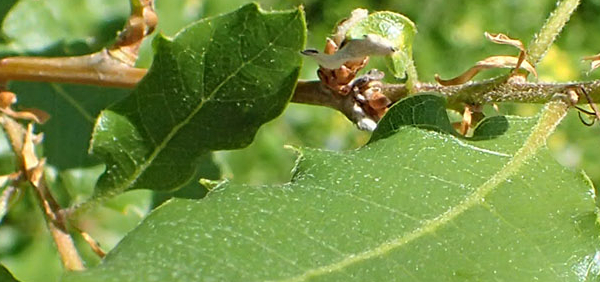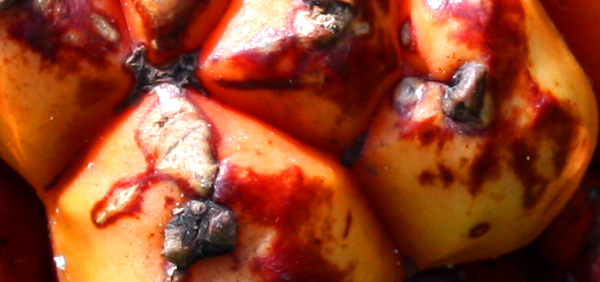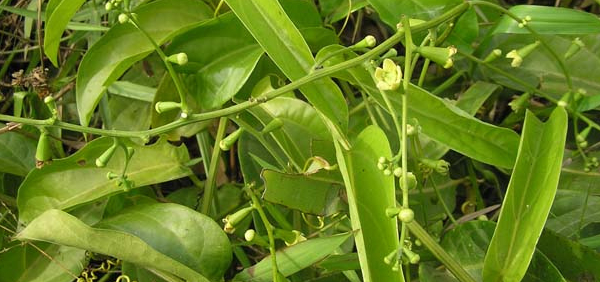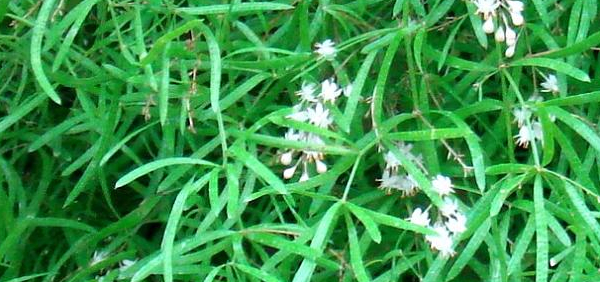tejpatra :

Tvakpatra consists of dried mature
leaves of Cinnamomum tamala (Buch. Ham.) Nees & Eberm. (Fam. Lauraceae):
a small evergreen tree upto 7.5 m high and
occurs in tropical, sub- tropical
Himalayas between 900-2300 m,
often raised from seeds,
sown in nursery,
leaves collected in dry weather
from about ten years old plant during OctoberMarch
HISTORICAL AND MYTHOLOGICAL REVIEW:
Historically, it is one of the oldest known and used spices.Taxonomical Classification
Kingdom: Plantae - Plants
Division: Magnoliophyta - Flowering plants
Class: Magnoliopsida - Dicotyledons
Family: Lauraceae
Genus: Cinnamomum
Species: Cinnamomum tamala
Allied species:
VERNACULAR NAMES
Sanskrit: tamalpatra, patra, tejpatram, palash, chandan, ram, tapasaj, gopan, anshuk, tamalaEnglish: cassia cinnamon Indian Cinnamon
Hindi: Tejpatra
Urdu: Tezpat
Telugu: Akupatri
Bengali: Tejpatra, Tejpata
Marathi: Tamalpatra
Konkani: tamal patta
Oriya: Tejapatra
Gujarathi: Tamala patra, Develee
Tamil: Lavangapatri
Malayalam: Karuvapatta patram ഇടനയില, കറുവപ്പട്ട ഇല, വഴന Itanayila, Karuvappatta-ila, Valana, Vazhana
Kannada: Tamalapatra, Dalchini Ele
Punjabi: Tajpater
Arabic: saynamum tamalaan
Assamese: Tejpat, Mahpat
Japanese: タマラ肉桂 タマラニッケイ, テジパット Tamara-nikkei, Tejipatto
Chinese: 柴桂 [chái guì] Chai gui
French: Laurier des Indes
German: Indisches Lorbeerblatt, Mutterzimt
Burma: Thitchabo
Nepal: तेजपत्ता, शिसि, सिनकाुली Tejpatta, Sisi, Sinkauli
Greek: Μαλαβάθρον Malabathron
Varities:
bay laurel, a tree of Mediterranean origin in a different genus; the appearance and aroma of the two are quite different. Bay laurel leaves are shorter and light- to medium-green in color, with one large vein down the length of the leaf, while tejpat leaves are about twice as long and wider, usually olive green in color, with three veins down the length of the leaf.Synonyms
Synonyms in Ayurveda: tamalpatra, patra, tejpatram, palash, chandan, ram, tapasaj, gopan, anshuk, tamalaRasa: Katu Madhura
Guna: Laghu Picchila Teeskhsna
Veerya: Ushna
Vipaka: Katu
Karma: Vathakaphahara
Its leaves have a clove-like aroma with a hint of peppery taste, they are used for culinary and medicinal purposes
Cultivation:
Propogation:
Seed - the seed of species in this genus generally has a short viability and is best sown as soon in containers as it is ripe Remove the fruit pulp since this can inhibit germination. Soaking the seeds for 24 hours in lukewarm water hastens germination, which can take 1 - 6 months at 20°c. The germination rate of fresh seed is about 50%, falling to 25% for seed 6 months old, and zero for those 1 year old. Stored seed should be sown as soon as possible in containers. When they are large enough to handle, prick the seedlings out into individual pots and plant them out into their permanent positions when 10cm or more tall.Cuttings of semi-ripe side shoots, 7cm with a heel, in a frame with bottom heat
Harvesting:
Leaves are ready for harvesting when trees are 10 years. Tree longevity is up to 100 years, and they continue bearing in old age. Leaves are collected every year from vigorous plants and in alternate years from old and weak ones. Collections are made in dry weather from October-March. Continuous rain diminishes the aroma of the leaves. Small branches with leaves are dried in the sun for 3 or 4 days and tied up into bundles for marketing. The average annual yield per tree is 40-100 kg/treePhytochemistry:
Essential oils (d-α phellandrene and eugenol).PHARMACOLOGY:
IMPORTANT FORMULATIONSParts used for medicinal purpose
Bark, Leaves, ,Dosage:
1-3 g of the drug in powder form.Antidote:
acts as an antidote for scorpion stingSubstitute:
The best substitutes are cinnamon leaves or fresh cardamom leaves, but these are also not easy to come by. Some prefer the South American boldo leaves: although their flavour is rather different, it is at least strong enough for the highly spiced Moghul foods. Easier and still satisfactory substitutes are a small piece of cinnamon bark or a dried allspice berry.Adultrants:
Since Indian bay leaves were hardly available in the West bevor the turn of the millennium, most older books encourage the use of laurel (the Mediterranean bay leaf) instead. Though looking similar, the taste is very different, and also weaker.Commercial value:
Morphology:
Leaves-
12.5-20 cm long, 5-7.5 cm wide at the centre, 3 converging
nerves from base to apex young leaves pink, petiole 7.5-13 mm long, margin
entire, apex acute or accuminate, both surfaces smooth, stomata paracytic odour,
aromatic, taste, slightly sweet, mucilaginous and aromatic.
Histology:
Petiole and midrib-transverse section of petiole and midrib
shows epidermis externally covered with cuticle, uniseriate, multicellular (1
to 3 cells), trichomes present, oil cells single or in group, isolated large
stone cells, much lignified showing striations found scattered, most of the
parenchymatous cells of cortex with reddish-brown contents, pericycle
represented by a few layers of sclerenchymatous cells, stele more or less planoconvex
as in the midrib of leaf, xylem on upper and phloem on lower side consisting of
usual elements, present.
Lamina-transverse section of lamina shows dorsiventral
structure, represented by palisade tissue on upper and spongy parenchyma on lower
side, epidermis same as in midrib, externally covered with cuticle, below upper
epidermis single row of closely packed palisade layer followed by multilayered,
irregular, thin-walled cells of spongy parenchyma without intercellular spaces,
idioblasts containing oil globules present in mesophyll and also in palisade,
lower epidermis covered externally with cuticle, lamina intervened by several
small veinlets: vascular bundles covered with thick-walled fibres on both side.
Geographical distribution:
South slopes of the Himalayas and the mountains of North Eastern India, extending into Burma. The main production areas are Nepal and Sikkim, but most of the harvest comes from wild or half-domesticated trees.ECOLOGICAL ASPECT:
C. tamala is found in tropical and sub-tropical Himalayas, Khasi and Jaintia hills and in eastern Bengal, India.Plant conservation:
Considering the economic potential and dwindling natural populations of C. tamala in several ranges, this species has been recommended for in-situ as well as ex-situ conservation by several authors. However, in the absence of standard agro-techniques and owing to lack of information on seed germination behavior, conservation efforts have not succeeded so farGeneral Use:
The bark is sometimes used for cooking, although it is regarded as inferior to true cinnamon or cassia Methanolicextract of C. tamala leaves fed at 10 mg/kg to alloxan-induced diabetic rats for 15 days resulted in significant reduction in blood glucose level, blood glycosylated haemoglobin, LPO, serum AST, and ALT, and significant increase in the antioxidant enzymes such as CAT, GSH, and SOD. C. tamala could be used as an adjunct therapy in diabetes.Therapeutic Uses:
ArsasSystemic Use:
- Diabetes. Taking Cinnamomum tamala three times per day for 3 months might lower blood sugar in people with diabetes.
- Common cold.
- Asthma.
- Stomach and intestinal problems.
- Skin diseases.
- Bad breath
Administration:
Bark powderPharmacological:
Leaves and bark have aromatic, astringent, stimulant and carminative qualities and used in rheumatism, colic, diarrhoea, nausea and vomiting.Clinical trials:
1. Anti-hyperlipidemic herbs in siddha system of medicine - Thillai Vanan3. Antidiarrhoeal activity of the standardised extract of Cinnamomum tamala in experimental rats
CV Rao, M Vijayakumar, K Sairam, V Kumar - Journal of natural medicines, 2008 - Springer
Research:
Precautions:
Toxicity studies:
There isn’t enough reliable information available to know if Cinnamomum tamala is safe or what the side effects might be.Use in other system of medicine:
It is used in cooking to add a specific flavour to food. It also has some medicinal properties.Bay leaves have a floral fragrance similar to oregano or thyme. They have been used as a flavoring by the Ancient Greeks and many Mediterranean cultures, as well as in the Americas. They are commonly used in soups, stews, meat and fish dishes and sauces. Bay leaves are a classic herb in traditional French cuisine. Typically the leaves are used whole or as part of an herbal garnish that is removed before serving the meal. They are also used in Thai and Arabic dishes, in particular Massaman Curry. In India they are used in Aram Masala.
Bay trees can live many decades. The leaves are harvested when the plant is a couple of years old. Fresh bay leaves are very bitter. The dried leaves have a deeper less bitter flavor. The older the leaf is the stronger the flavor. The oil is used by the perfume industry. The wood is also sweet-scented.
The name Lauris nobilisis derivies from the Latin “laurus” meaning to laud or praise and “nobilis” meaning noble. Esoterically, the leaves are considered a noble and strong protector that have the ability to attract the “right place” to you. The leaves can be burned to purify the air, providing comfort and freshness to a room.
In early Greece annual athletic competitions held to honor Apollo. The winner was crowned by a wreath of bay, also called, bay laurel leaves. In modern Greece, the bay laurel is called Daphne and the tree’s boughs are a national symbol. The term “baccalaureate” originates from the giving of the bay leaf crowns to signify success. The Romans held bay laurel to be a symbol of victory.
CONCLUSION:
Cinnamomum tamala, Indian bay leaf, also known as ತಮಾಲ (Tamaala) in Kannada(ಕನ್ನಡ), மரப்பட்டை இலை (Pattai Illai) in தமிழ்(Tamizh), tejpat, tejapatta, Malabar leaf, Indian bark, Indian cassia, or malabathrum, is a tree in the Lauraceae family that is native to India, Bangladesh, Nepal, Bhutan, and China. It can grow up to 20 m (66 ft) tall. Its leaves have a clove-like aroma with a hint of peppery taste, they are used for culinary and medicinal purposes. It is thought to have been one of the major sources of the medicinal plant leaves known in classic and medieval times as malabathrum (or malobathrum).Ayurvedic Formulations:
Common Ayurvedic Formulations of tejpatra with their IndicationsLala Dawasaz Herbal Hair Oil
KEY WORDS: tejpatra Cinnamomum tamala Nees & Eberm. Bay leaf
- » Classification and names of tejpatra
- » Synonyms and definitions of tejpatra
- » Drug Properties of tejpatra
- » Chemical Constituents of tejpatra
- » Standardization of tejpatra
- » Parts used and Dosage of tejpatra
- » Morphology and Histology of tejpatra
- » Distribution and Conservation of tejpatra
- » Cultivation of tejpatra
- » tejpatra in the market
- » Medicinal Uses of tejpatra
- » Researches and clinical trails of tejpatra
- » tejpatra in other sytems of medicine
- » Ayurvedic formulations with tejpatra
- » Images of tejpatra












